The new long distance machine others will be chasing for years. The new long distance machine others will be chasing for years with the world's largest storage capacity with over 41 gallons. VICTORY CROSS SERIES Choose the Cross bikes for traditional styling with the modern technology only Victory brings to riding enthusiasts. It starts with the 106 cu. in Freedom V-Twin with power and torque for exhilarating speed at the twist of the wrist. With a 6-speed overdrive transmission these bikes have the long legs for all-day cruising. Our all-aluminum backbone frame provides light low-speed handling and impressive stability in corners and at speed. Combined with a range of windshields and storage choices and you have a bagger for everyone who wants to travel in style and comfort. NEW TRUNK FOR VICTORY CROSS COUNTRY/CROSS ROADS Touring riders can put away their tools. The new Lock & Ride® Trunk from Pure Victory can be installed on a Cross Country or Cross Roads in seconds, and removed just as quickly - without tools. To install a trunk, a rider simply aligns the trunk mounting legs with mounting points at the rear of the bike and snaps down the locking arm. The trunk's power cord connects easily to the bike's electrical system to power the taillight at the rear of the trunk lid, the audio speakers and the accessory power outlet inside the trunk. To remove the trunk, simply reverse the process. When the trunk is on the bike, a locking pin can be added for theft prevention and additional peace of mind. oThe trunk has more than enough room for two full-face helmets. oThe trunk lid seals securely, is lockable and provides the bike with a high-mounted taillight. o The front face of the trunk has a comfortable, padded passenger backrest and dual audio speakers. o Each 2011 Cross Country and Cross Roads comes with a spare lock cylinder so a trunk can be locked with the bike's ignition key. oTrunk-related accessories available from Pure Victory include: Passenger Armrests, Trunk Luggage Rack (mounts atop lid), and Trunk Liner PROVEN OUTSTANDING RELIABILITY Victory has a track record of consistently outstanding reliability and dependability, which has led to the industry's highest customer satisfaction ratings. This proven reliability, along with the new transmission design, allows Victory to recommend extended oil service intervals for 2011 drivetrains. oThe recommended oil change interval for 2011 models is every 5,000 miles (8,000 km). oLess-frequent oil changes results in a lower cost of ownership. NEW TRANSMISSION The Victory drivetrain team scrutinized every component of the engine and transmission and fine-tuned the designs and performance of numerous parts. Approximately 40% of the drivetrain is new for 2011, with the transmission receiving so many improvements it is virtually a new transmission. The changes: improved manufacturing efficiency and quality assurance; enhanced drivetrain's already-impressive reliability; improved engine performance; and, for riders, improved ridability and delivered a more appealing-sounding transmission. oIn terms of operating sound, selected modulation frequencies have been eliminated. This produces a more-appealing sound - consistently in each gear. In 4th and 6th gears in particular, gear whine has been reduced. oDriveline lash has been reduced by 66%. o"Neutral Assist" has been added to make it easier for a rider to shift into neutral when stopped. This will reduce the rider's effort, will reduce clutch wear and will lessen the performance demands on the oil. ENHANCED INSTRUMENTATION All cruisers now have instrumentation similar to that of the Victory Cross Roads, which provides a rider with a wealth of information in one, easy-to-read location. The new instrumentation includes: o An analog speedometer, which may be set to show MPH or KPH. oBlue backlighting. oA large LCD that displays: Clock (time of day is viewable at all times), gear position, tachometer and diagnostic readouts for Victory dealership service technicians. o The gauge face includes lights such as high-beam and neutral indicators and the oil warning light. Cruisers no longer have these indicator lights atop the triple clamps. oThe Cross Roads instrumentation also has an always-viewable fuel gauge. CHASSIS CHANGES ACROSS THE LINEUP All brake calipers, rotors, lower belt guards, and floorboards are black. oAll left- and right-hand switch cubes are black, as are the audio control switch block and cruise control switch block. o The triple clamp is black on all models except the Vegas Jackpot (which retains its chrome triple), and the Victory Cross Roads (which retains its brushed finish). o A new side stand on each model features an integrated hooked-end design for easy locating and easy control of the side stand. o All cruiser exhausts have a larger outlet for improved sound quality and a lower exhaust note. VICTORY CROSS ROADS The Victory Cross Roads is an extremely smooth, powerful and comfortable touring model. Multiple options allow the rider to tailor this motorcycle for any type of touring. All Victory Cross Roads Series Models Features o Strong, innovative two-piece, sand-cast hollow aluminum frame. o Air-adjust rear suspension with 4.7 inches/120 mm of rear travel. o Dual disk front brakes and inverted forks. o 22.0-liter fuel capacity. o Instrumentation includes analog speedometer, fuel gauge, odometer, trip meter, and indicator lights. o Ultra-bright, multiple-LED turn signals and flush-mounted taillight. Cross Roads o 69 Litres leather soft bag capacity Cross Roads Deluxe o79 Litres Lockable hard bag storage capacity o Easily detachable screen o Touring seat Cross Roads Series Colour Options o Crimson Red o Solid Black New Colour-Matched Lock & Ride® Trunk Available o New Lock & Ride® Trunk available as a Pure Victory accessory. o Trunk can be installed or removed in seconds - without tools: Align its mounts, lock it in place, connect power cord and ride. o Spacious trunk can hold two full-face helmets and have room to spare. o Trunk features comfortable passenger backrest and two audio speakers. o Trunk lid seals tight, is lockable and provides bike with a high-mounted taillight. o Available trunk accessories: Passenger Armrest Kit, Trunk Cargo Rack, Trunk Liner. Pure Victory Accessories for the Cross Roads Include: o Lock & Ride® Trunk, Trunk Cargo Rack, Trunk Liner, Passenger Armrest Kit, and Chrome Saddlebag Protectors. o Stage 1 Exhaust, Cross Roads Light Bar, Tach Kit and more Victory Cross Country Tour Model Highlights •World's Largest Storage Capacity 41.1 gallons •Victory Comfort Control System •Taller windshield deflects more wind/rain Victory Cross Country Tour Features and Benefits 106 CUBIC-INCH FREEDOM V-TWIN At the heart of the Cross Country Tour sits the Freedom V-Twin power plant, expertly balanced for the perfectly controlled explosions that deliver 97 horsepower and 113 ft lbs of hole shot torque. Maestro of the motorcycle world, it's what keeps man, machine and highway working together in perfect harmony. 6-SPEED OVERDRIVE TRANSMISSION The highest performing transmission on the road receives the power generated by the massive V-twin and seamlessly turns it into something you can use. Neutral Selection Assist and helical-cut gears ensure every shift is as quiet and smooth as the one before it. ABS BRAKES Standard on the Cross Country Tour, the Victory Anti-Lock Brake System doesn't discriminate between dry, wet or rock-strewn pavement. No matter what the conditions, ABS monitors what the wheel is doing and gives you consistent, smooth braking from the handlebar lever down to the rubber on the road. VICTORY COMFORT CONTROL SYSTEM Since Mother Nature seldom listens to the weather requests of motorcycle enthusiasts, we've taken means to accommodate her. Down below the knees, we've given the Cross Country Tour dual fairing vents (as well as a storage box). Close 'em for complete protection in cold or rain, open 'em wide when the weather's more agreeable. CRUISE CONTROL After making every other aspect of going the distance as effortless as possible, the throttle hand still had a beef about being overworked. By adding precise, automotive-style cruise control, the right mitt can now simply hang on and enjoy the ride. 4.7 INCHES OF REAR SUSPENSION TRAVEL Just in case the open road gets too lonely the class-leading rear suspension features an easily adjusted air shock and coil spring, ensuring a smooth ride for you and any adventure seeking passenger. TOTAL STORAGE Add up lower faring space, trunk and saddlebags and you get an amazing, best-in-class 41.1 gallons of storage space. SADDLEBAG AND RAILS With lockable latches and 21.3-gallon capacity, the Cross Country Tour can protect from theft and accomodate a passenger that doesn't follow the "travel lightly" rule. Exquisitely designed chrome rails provide style as well as tip-over insurance that you'll be grateful for when your brother-in-law asks to ride. HEATED SEATS AND GRIPS The Cross Country Tour lacks for nothing in the comfort category, and as proof we offer up heated seats and handgrips as exhibit A. Together they offer the best means of enhancing your road warrior reputation by adding precious road time to both sides of summer. TALL WINDSHIELD To maximize comfort, we've raised the windshield, resulting in reduced buffeting and increased wind and rain protection. 26.25" SEAT HEIGHT Rule of the road: the lower the seat height, the more control. The Cross Country Tour has the lowest seat in its class. Unless you admit having the toe strength of a ballerina, you want to be able to plant both feet firmly on the ground. HID LIGHTING A machine that looks this good deserves to be seen. The High Intensity Discharge headlamp shines four times brighter than standard halogen headlamps and shouts 'HERE I COME' four times louder. Since it also lasts 10 times longer, you can see your way ocean to ocean with every mile marker perfectly illuminated. ADJUSTABLE PASSENGER FLOORBOARDS When the passenger floorboards are easily adjustable, any height passenger can find comfort. That's the long and short of it. 12V SOCKET Power from the engine can now be sipped to charge phones, cameras, or anything that uses a 12v socket. Sometime during your long distance cruise you may need to call in support for that rider stranded with a lesser motorcycle.
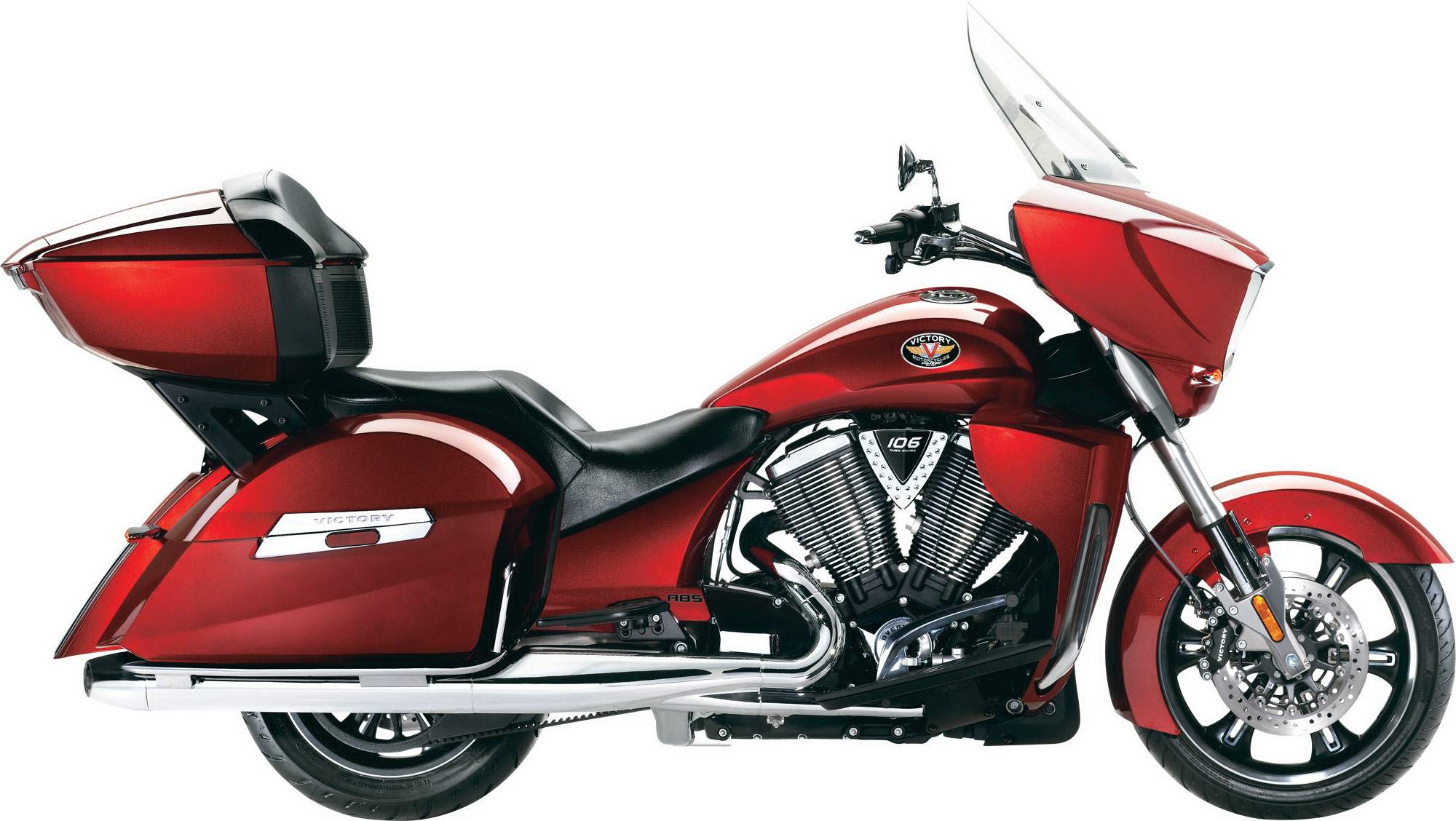
Motorcycle Review Before arriving in Austin, my wife Jane and I were given a few photos and a brief description of the new 2010 Victory Cross Country motorcycle, so we had formed an image of what to expect. First sight of the Victory Cross Country revealed that our anticipation had not been nearly strong enough; a stunning example of motorcycle artistry greeted us. Painted metallic Midnight Cherry red, the Cross Country's sharp lines appear faceted out of cultured ruby. Angular design elements bring to mind experimental aircraft of the early jet era, yet defy placement in a specific period of the motorcycling milieu. Triangles appear scattered throughout the motif, beginning with the inverted triangle of the headlight cowl, continued in the triangle circumscribed by the cylinders with the EFI cover wedged between, and finalized in the tapered, flush-mount LED taillight. Normally, I prefer to spend some time with a motorcycle before having Jane ride with me. However, she is only in Austin for a single day, so there is little time for such formalities. Fortunately, the Cross Country proves a delight to pilot with a passenger. Its lightweight hollow cast aluminum frame, which uses the engine as a stressed member, gives the Cross Country the lowest center of gravity in its class. There is no hint of top heaviness, and the bike requires little input to prevent wandering at slow speeds. The low seat height of just over 26 inches (unladen), adds to rider control when dealing with stop-and-go traffic or walking the bike through parking lots. Possessing a map of the Texas Hill Country, I roll on the throttle. The 50-degree V-twin Victory Freedom 106 engine builds revs with a comforting growl from the split dual exhaust, effectively applying its 96 horsepower and, most importantly, 109 ft/lbs of torque to the Dunlop Elite 3 tires. Fed through EFI with dual 45mm throttle bodies, the Victory Freedom 106 utilizes a single overhead cam with four valves per cylinder. This supplies a high volume of air through a light weight valve train, allowing the engine to produce a wide torque curve from midrange to high rpm. Engine response is superb and shifting through each of the six gears is smooth. With the state capital in the rear-views, we head into the Texas Hill Country, the region of Central Texas along the Balcones Escarpment, with Austin to the east and San Antonio to the south. The topography is rolling, sometimes rugged, limestone hills covered with oak and cedar. For our purposes, the Hill Country is a series of meandering two- and four-lane roads linking a diverse collection of small towns, each with its distinct interpretation of Texas culture while conforming to the overriding theme of rugged individualism. These wonderful little towns urge a stop to investigate and shop, making them a perfect proving ground for our impeccable touring machine. The 21 gallons of storage in the Cross Country's hard saddlebags should handle the clothing and supplies required for this trip, as well as souvenirs picked up along the way. All can be packed conveniently in the provided bag liners. The Victory saddlebags have an internal locking latch that secures the top hinged lid to the bag body. However, my overstuffing of the bag bulged the sides outward. On several occasions, the overstuffing caused the saddlebag lids to open while riding, even after I believed I had ensured that they were safely clasped. Careful packing seems to be the key to keeping the lids closed. Distance is deceiving here. Even with a 60 mph limit on many of the two lane roads, the time it takes to get between two points on the map is blissfully prolonged. Each crossroads provides new sights that must be scrutinized to determine if they require further investigation. Every dip in the road leads down to a creek running through culverts under the road with signs warning of possible flooding. Around every hill a new scent greets us, distinctly earthy and palatable. Travel by motorcycle encourages the use of all senses to envelop oneself in the environment, and the Cross Country moves us through this environment in an undisputedly enjoyable fashion. As the evening approaches, Jane and I ride the Cross Country to our one firm destination of the day, The Salt Lick Bar-B-Que, in Driftwood. The Salt Lick restaurant is a local institution, borne out by the projected two-hour wait. Buses loaded with University of Texas Longhorn fans are pulling into the expansive parking lot as we arrive. The attendant directs us to pull into an area normally reserved for employees to ensure the Victory is secure away from the throng of vehicles coming and going. The crowd is daunting but the enticing smell of smoked meat coming from the decades old pit barbeque draws us in.
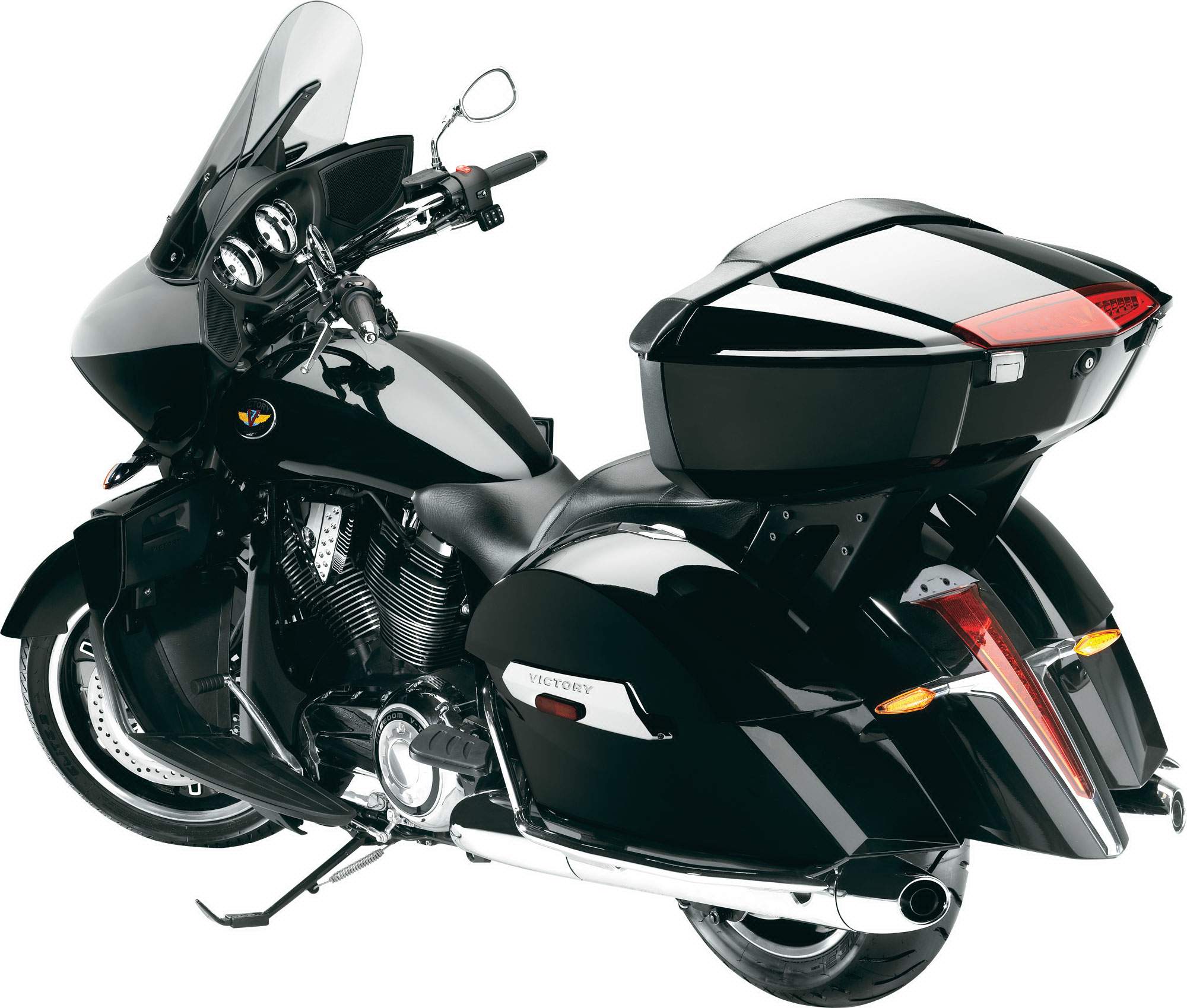
The Salt Lick is a sprawling complex of stone and grey woodplank buildings with a number of separate dining rooms and a large picnic area with a band. We learn from observation and overheard conversation that the trick to a quick meal is going directly to the pit house and ordering food to go. Jane and I both order a combination plate, which is prepared in a few minutes, and take our food to the picnic tables near the band. The atmosphere is lively and cheerful due to the Longhorn victory over neighboring Oklahoma. As she had been seduced by the comfort and rideability of the Cross Country, Jane reluctantly boards her flight back to California, sorry that she cannot accompany me for the rest of the trip. As a passenger, one criteria Jane looks for in a motorcycle is the smoothness with which it transitions, be it between gears or from start-to-stop and back. With a precise six-speed transmission, wet multi-plate clutch, and carbon fiber reinforced drive belt, the Cross Country scores high in this category. With its comfortable seat and backrest, it is easy for Jane to imagine herself spending the next four days with me on the Cross Country. Preparing for my ride home to California, I decided on a course from Bandera to Sonora, with as little time on major highways as possible. Bandera is an authentic cowboy town surrounded by working cattle and guest ranches and is a popular stop for motorcyclists making the circuit around the Three Twisted Sisters, the loop consisting of Ranch Roads 335, 336, and 337. I reach Bandera in time for an early lunch, so I order some food at the Dogleg Coffee House on Main Street across from the general store. While the amenities of the Dogleg are modern, the building itself is made of limestone block and looks like it could have been a jail or bank in a previous incarnation. All the shops and restaurants along Main Street are well maintained yet direct one's mind back to a time before internal combustion. Each step through town leads to a photo opportunity of some idyllic Americana. Each building looks to be hewn from the history pages of the Old West. With noontime approaching, I head west to experience some of the premier motorcycling roads offered in the Hill Country. Just past Vanderpool, Ranch Road 337 starts to climb and twist as the rolling hills gain elevation and become more severe, exposing faces of jutting limestone framed by oak and cedar. Long vistas of the land north of the Balcones Escarpment can be seen. I head down to the Frio River and the town of Leakey, where I pick up RR 336, arguably the most thrilling of the Twisted Sisters. Initially, RR 336 follows the West Frio River for a scenic ride through expansive ranges, marked by frequent cattle guard crossings, which are effectively smoothed out with the air adjustable rear suspension and the inverted cartridge forks with progressive springs; both ends offer about five inches of welcome travel. Soon, the road heads up to a broad ridge that borders the west bank of the river, and then turns into a roller coaster of two-wheeled bliss. Climbing and diving with frequent swooping turns, the scenery attempts to distract my attention away from the road, but the tarmac is too inviting. Adrenalin claws at my hand to twist harder, brake later, push for more lean. How far can I take the Cross Country? The Victory's rigid frame, sport-aware suspension, and 300mm floating rotor disk brakes with four-piston calipers give the Cross Country a carving ability akin to a much lighter bike. Too soon I am approaching Sonora and Interstate 10. I am told that riders often ride the Twisted Sisters a couple of times in a day. Unfortunately, I must keep to my schedule. The Interstate calls for a different state of mind, one that the Cross Country accommodates. The stretch of I-10 that leads out of Texas through New Mexico seems endless, but highway luxury is easily at hand without removing your grasp from the grips. Operating a trigger switch on the left handlebar with your index finger can change each mode of the trip LED display. You can flip the display to read odometer, two trip meters, average fuel consumption, average speed, fuel range, fuel mileage, and trip timer. An integrated 40-watt audio system is controlled from a set of switches inside the left grip, allowing me to set the system to AM, FM, weather band, and MP3 player. In MP3 player mode, I can select playlists or scroll through my files by album or artist. The audio system also has an auto-fade feature that permits you to set the volume while stopped, and the system will automatically increase the volume as your speed increases. Flexible body positioning is a great defense against fatigue, and the ergonomics of the Cross Country provide many opportunities for personalization. The rider's floorboards are long and offer a wide range of options for foot placement. The foot controls are adjustable to accommodate different leg lengths. Even without highway pegs installed, the forward swept wing shaped highway bars provide a nice place to push your feet against to change the pressure points on your gluteal muscles and lower back. The seat has extra padding and provides a small amount of back support. Using the standard electronic cruise control makes running the tank dry before having to stop to stretch your legs a regular occurrence. West of Las Cruces, the sky fades into the darkness of what is obviously a storm. Just before reaching the Border Patrol checkpoint between Las Cruces and Deming, I enter the brown wall of dust and rain that delineates the outflow boundary of the tempest. I angle into the heavy crosswind as much as possible, trying to dodge tumbleweeds and shrubs. The Cross Country handles the high crosswind with the same confidence it displays during normal riding conditions. A heavy downpour with hail hits just as I ride under the awning of the Border Patrol checkpoint. The large awning does not protect from the wind, but does provide some shelter from the heavy rain and hail. This gives me a chance to pull a tumbleweed out of the forks while escaping the heaviest of the downpours I encountered. The Cross Country's fairing is designed to channel rain away from the rider's hands, and adding the tall touring windscreen delivers even more protection. The next morning, clear skies and a clean Interstate 10 greet me. Motorcycling north through Arizona on US 191, I make Flagstaff for my final night on the road, leaving me an eight-hour ride across the Mojave Desert to home. Over dinner I consider the coming final day of my trip and how the Cross Country has been a consummate companion. Whether riding solo or two-up, on Interstate or rural road, the 2010 Victory Cross Country is a most appropriately named motorcycle. Unique styling, well-designed accoutrements, and ample performance position this American motorcycle as one of the premier distance killers available.
Source Motorcyclingmag.com


Victory Cross Country Tour Review
A Season on the 2012 Victory Cross Country Tour
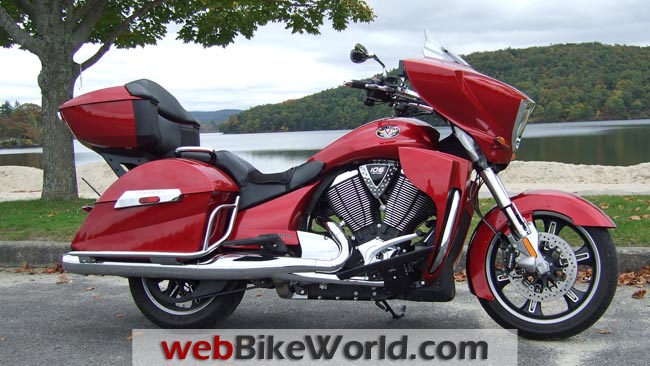
Here in the Northeast, it’s just about the time that I add fuel stabilizer to the tank, run the bike for a few minutes, and call it a season.
The now-motionless bike in my garage is a Victory Cross Country Tour, and the season in question was my first on it.
Since the Cross Country Tour was new, not only to me but to everyone else, you might be interested in my impressions.
Here’s how that season went, how the bike performed, what’s particularly good about it, and what needs work.
A Short History of the Cross Country Tour
For the 2010 model year, Victory introduced a couple of fraternal twins, the Cross Roads and the Cross Country.
These “Cross” models – generally designated “XR” and “XC,” respectively are traditional-looking V-twin baggers.
They have the same 106 cubic inch (1731 CC) air/oil-cooled, fuel-injected, SOHC, four valves per cylinder engine (whew!).
Victory uses this powerplant across-the-board now.
The XR and XC also share Victory’s six-speed transmission, belt final drive, twin disks up front and single disk out back, ABS, and both have an 18″ front and a 16″ rear wheel (although the XR’s are spoked and the XC’s cast, with tubeless radials on the latter).
The XR has a fork-mounted windshield and minimalist instrumentation; soft saddlebags are now standard.
The XC, on the other hand, has a fork-mounted “bat-wing” type of fairing, more extensive readouts and sound system, and hard saddlebags; the XC also adds cruise control as standard these days.
You can read all the specs and pricing as you work your way through the Victory Motorcycles web site .
One of the options for the XC was a top case. (It doesn’t seem to be offered for the XC for 2013, which is just as well – it added almost 10% to the price of the base bike).
For the 2012 model year, Victory started with the XC, did a little tweaking, added a bunch of options, and called their new creation the Cross Country Tour (or “XCT”).
The major additions to the Cross Country that comprise the Cross Country Tour are:
- Top case is standard.
- Heated seats and grips.
- Adjustable passenger mini-floorboards.
- A taller windshield (more about that in a minute).
- An HID low-beam for the headlight (and more on that, too, later on).
- Tubular front crash bars (like the XR; the XC has flat-style bars).
- Storage-pod lowers.
- An air-management system, which includes adjustable fairing-mounted winglets and adjustable openings in the lowers.
In 2012, the Victory Cross Country Tour list price was $21,999 in black, $22,499 in red or white.
And my simplistic color names don’t do the paint job justice, as we’re talking a sort of metal-flake, even in black…
For 2013, the choices are now black ($21,999, as before), or blue and a kind of bronze (all upped $100 to $22,599).
Keep in mind, however, that Victory runs a lot of special promotions, e.g., if you take a demo ride, go to a show, get on their mailing list, etc.
Also, there’s some bargaining room, or at least there was, back in January, 2012, when I actually signed the paperwork; at that time, there was a rebate program, and a discount for veterans, and a dealer incentive kickback, so I saved a lot of money.

Putting the Cross Country Tour Through Its Paces
I picked up my XCT, fresh from the crate, in late March. During the season, I did about 2,000+ miles of super-slabs, including a 600-mile day and a couple of 400-mile days.
At the other extreme, I rode The Dragon at Deals Gap, forward and back, along with many of that area’s great roads en route. Mostly, however, I did a lot of 200- to 300-mile day trips.
I live in the Albany, New York region, so my rides include the back roads of the Catskill, Adirondack, and Berkshire mountains or two-laners to Connecticut or Massachusetts to check out pizza and hot dog places for lunch and so forth.
Most of my riding was solo, but some was two-up with my wife, often for more than an hour at a time in between stops. Ambient temps ranged from 50 or so to the high 90s.
Some – not much, but some – of the riding was in mild rain, and some in pretty heavy rain. In short, I put the XCT through its paces. All told, I put about 8,400 miles on it in seven months.
So, how did it do?
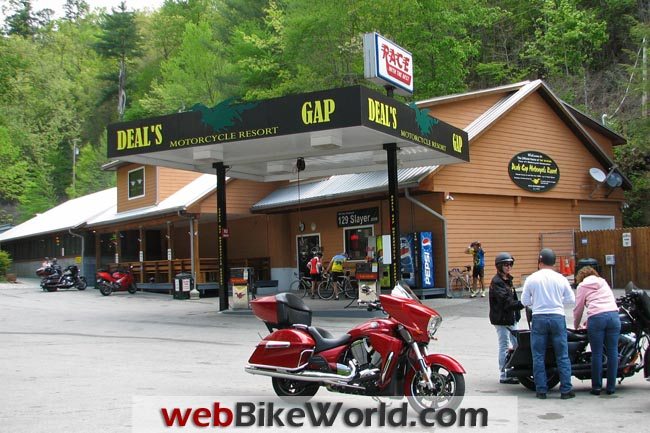
Ride Quality and Handling
The ride quality of the Victory Cross Country Tour is great.
It’s stable in a straight line, but I don’t know what the top end is, but I “cracked the ton” a few times (professional rider, closed course, etc.), easily and without any drama.
It’s neutral in turns, and it has excellent ground clearance… yes, you can add the caveat “for a cruiser” or “for a tourer,” but, after all, that’s what we’re talking about here.
The floorboards fold up 5 or 6 degrees (I put an angle gauge on them a while back).
After that, the next thing to touch down will be an exhaust shield (my experience) or some part of the bag guards (others’ experiences).
The Cross Country Tour, by the way, uses a sensible (for handling) 180/60R16 rear tire (although Victory does offer some special phat-tired, hard-to-steer cruiser models, if that’s what you’re looking for).
No tracking of rain grooves, wobbling, or other handling anomalies.
There is minimal vibration (except when cracking it WFO, of course), even – and here’s a novel concept – at idle.
The XCT employs an aluminum frame and inverted forks (more rigid and less unsprung mass than “conventional” forks, don’tcha know).
Further, it has real suspension: there’s approximately 5″ of travel in both the front and rear.
The front suspension is non-adjustable, and seems well set up to me; the rear is a single air shock, adjustable via a Schrader valve under the right side-cover.
The size of the Cross Country Tour is in the same realm as most other full-dressed touring rigs. Victory lists its “dry weight” as 845 lbs.
I have no idea what it really weighs, when you add on such frippery as 5.8 gallons of high-test, five quarts of oil, and whatever else “dry weight” excludes (fork oil? battery?).
But both the seat and center of gravity are extremely low, so if you’re used to big bikes at all you’ll have no problem here.
The seat height is listed as 26.25″, and it’s definitely low; not only can I flat-foot it at stops, but my knees are bent, as well.
(By the way, I believe that H-D lists measures height with some person of some weight actually sitting on the bike. So, cross-brand “seat height” comparisons may be as meaningful as, oh, weight comparisons).
What looks like a fuel tank actually is a fuel tank on the XCT.
While the fuel is up high, the bike is not top heavy; I guess the engine’s weight and placement, and the frame geometry, renders that a non-issue.
Even the battery is nicely placed for handling and C of G; it’s at the very bottom front of the bike, underneath the oil cooler (and you can get to it by removing four bolts, underneath the bike, that hold its covering panel in place).
If you’re not familiar with bikes of this ilk, I won’t give you any baloney like, “Once underway, it feels 500 lbs. lighter.” It’s still a big bike, and you won’t be out-carving the nearest supermotard.
And you may want to practice hanging off for U-turns in some vacant parking lot (no, not hanging off the inside – the outside, you young crotch-rocket whipper-snappers).
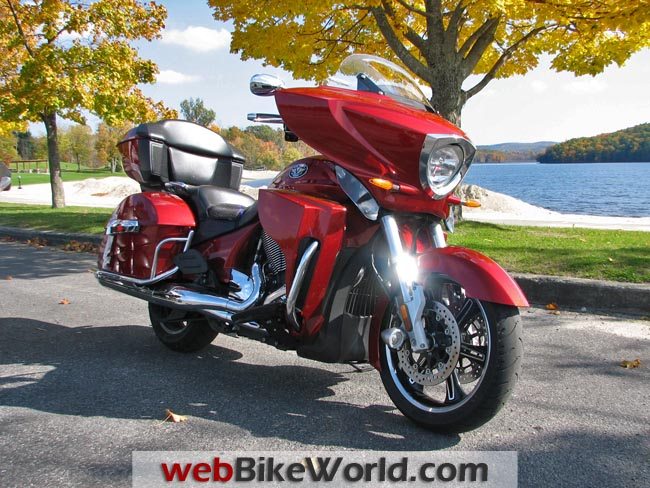
Getting the Power Down
The engine has plenty of power and torque.
Some folks feel that there’s never enough motor, this side of a blown Boss Hoss, or maybe whatever that concoction was where someone put a Dodge Viper engine in a concept that sort of looked liked a bike.
Back on Earth, however, the basic 106 cubic inch engine is more than adequate.
There’s never a problem getting underway from a standstill, even with a passenger.
You don’t need to shift down to pass, but if you’re in an absolute rush on two-lane blacktop, dropping down to fourth will take you past 100 in a hurry.
Sixth gear is used for loping along the Interstates.
I’ve been consistently getting low 40s for an MPG reading, whether on the highways or briskly riding back roads; I imagine you can get more than 50 MPG if you ride leisurely in 55MPH zones all day. Premium fuel is specified.
The transmission is not a “snicker,” but it’s not a “clunker,” either.
Works fine, no noticeable drive-line slop, no missed shifts. The cable-operated clutch has a good engagement range.
As an extra added attraction, there’s a trick neutral-assist function, akin to that of some Kawasakis of the last few years.
When you’re below 5MPH – stopped, for instance – all you have to do is shift up from first, and there you are.
That is, instead of maybe going into neutral or maybe going into second, you’re most definitely put in neutral.
There’s no gingerly playing around with the clutch, or rolling the bike a few inches back and forth; you just shift up to neutral.
Once the light turns green, you shift down to first, get underway – at which point hopefully you’re doing more than 5 MPH – and then just shift up to second, etc.
The triple-disk brake system gets the job done. I’d like a little more initial bite from the front brakes, but they’re linear and up to the task. The brake lever has a thumbwheel for reach adjustment.
The front tire is a braking-and-handling-sensible 130/70R18. The ABS is unobtrusive.
I don’t believe I’ve gotten the front to kick in yet. If you’re experimenting in this regard, it’s much easier, and safer, too, just to stomp on the rear-brake peddle.
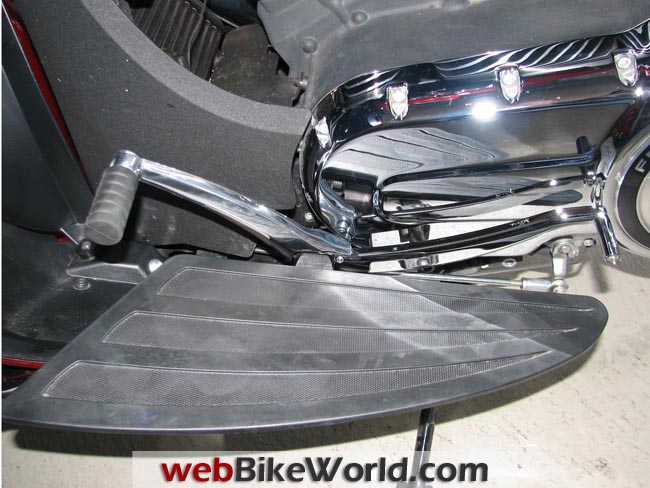
To me, this is a highly significant part of the touring equation. The Victory Cross Country Tour seat is very comfy, fore and aft. Up front, nothing, um, gets squashed.
There’s an upturn before the pillion area, which I think should be positioned just a tiny bit more rearward. By the way, I’m 5’9″, with a 30″ inseam. The reach to the handlebars is just about right.
On the one hand, I’m thinking of replacing them with some 2″ pullbacks.
On the other hand, I’ve used bar-backs/risers on every bike I’ve owned, so I seem to prefer a more straight-up riding position, or at least have significant bend in my arms in normal riding.
Incidentally, as a result of the dash configuration, you can’t add risers – a bit of a shame – so you have to replace the handlebars if you want to bring them closer.
The floorboards are class-leading (long), according to Victory; they’re certainly the longest I’ve ever seen. You can move your feet from about straight down to straight out, depending on your inseam.
Of course, you 6’4″ types may still want highway pegs added up front. But the point is, as sold, this is quite a relaxing environment.
The shift lever is three-position fore-and-aft adjustable, and its height can be adjusted via a threaded rod; you have to let it come up pretty far on the uptick, so I guess a little shorter throw would be nice.
Out back, my wife tells me that she’s never had a better view, because the pillion portion is raised up (she considers this both a plus and a minus, as she sometimes doesn’t want to see what I’m doing, in terms of what’s ahead).
Anyway, the seat’s also comfy for her, and the modest wrap-around curvature of the top case makes her feel sufficiently secure. The backrest is well padded and its angle is fine.
By contrast, we rode a Valkyrie Interstate for seven years, and although I kept the stock seat, I replaced the backrest on the top case, essentially just to change that angle.
And for my former 650 Burgman Exec, I had a backrest for the Givi top case custom made by a local upholsterer…
Last and most assuredly not least, the Cross Country Tour passenger gets mini floorboards, adjustable for height (three positions) and angle (through a modest arc).
We have availed ourselves of these adjustments, to the point where I know the torque value for the two-bolt adjustment.
Victory also offers a reasonably priced option for passenger grab handles. Well, you might be thinking that these should be stock, and I might agree with you.
On the other hand, these are really nice handles, and they’re the most robust grab rails I’ve ever seen; with the proper straps and hoist, you could probably lift the back end of the bike off the ground with them – maybe even the whole bike.
Disclamer #1: The passenger grab rails you see on my bike are not stock!
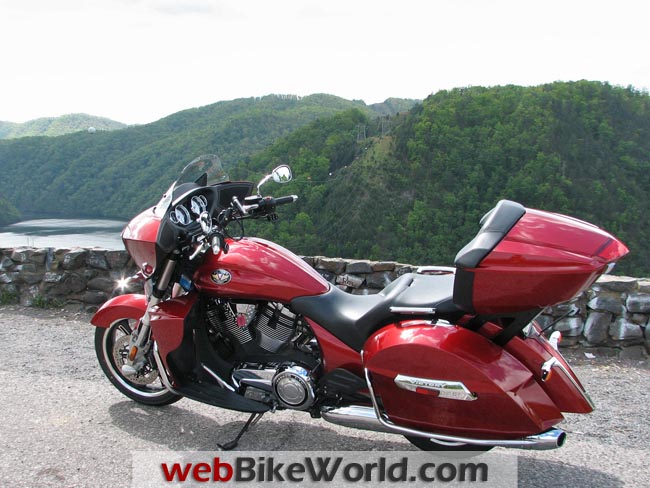
Air Management
Let’s start with the windshield. Recall that the XCT one-ups the XC by adding a new, tall, windshield (along with some new brackets, to hold it in place). I did some demo rides on the XCT prior to buying it, and that windshield is too tall for me.
Pretty much everyone has to look through it, even if you shop at the Big and Tall stores.
Me, I already wear glasses, and then look through at least the shield on my modular helmet, and maybe its internal sun visor, too.
That’s enough.
Regardless, I’m a look-over rider, not a look-through one. So the stock windshield was a non-starter.
Luckily, the XCT is shipped in a crate sans windshield. The dealer agreed to install a different windshield for me, for free, since he had to put one on, anyway.
(By “free” I mean there wasn’t a charge for labor, just for the new windshield. I sold the stocker on eBay).
I bought the KlockWerks “Flare.” Don’t confuse this with the Victory-brand “Flip,” both of which are sold through Victory dealers.
The Flip is just a “shorty” type of windshield, while the Flare is a little larger and adds a curved-up top edge.
The Flare works, in terms of moving any significant buffeting over my head, and my wife says that it’s fine even way back there.
Disclamer #2: The pictures you see here do not depict a stock windshield!
Some people might actually like the stock windshield, especially if you’re already a look-through person. I’ve ridden behind it at several demos, as well as some extended stints on a friend’s Cross Country Tour.
It’s clear, and it creates an extremely calm pocket of air. I find it too calm; almost stagnant.
However, if you don’t wear a full-face helmet, or generally don’t like a breeze, it may be your cup of tea, especially in cold weather.
And if you want to add some air to the mix, you can open the winglets (see below).
For those of you who haven’t experienced electrically adjustable windshields, they’re a very nice feature for touring.
Unfortunately, I’ve never seen that functionality on bikes with fork-mounted fairings, and the XCT is no exception: it doesn’t have that capability.
You can, however, get a mount (with or without their windshield) from MadStad (see Victory Resources, below) that has a manual adjustment system; that mount has recently been redesigned and looks sleeker, as well as being a useful option in the windshield arena.
Next, regarding air management, there are winglets attached on either side of the fairing, just above the storage pods in the lowers.
They can be rotated from a blocking position – an adjunct to the fairing itself – around to an on-edge position, in terms of incoming air.
In conjunction with a scooped area between the pods and the tank, they do a great job of letting you control the airflow to the upper torso.
Last, the storage pods/hard lowers have their own air-control doors.
These are less intuitive: opening them all the way does not provide the most cooling relief to your legs on hot days. What happens is that if you do that, you’ll mix too much engine heat with the incoming air.
Instead, given a lip at their inner rearward edge, you have to experiment with partial openings for maximum unadulterated fresh air.
This also depends on how you position your legs, i.e., forward or back on the floorboards, and toward the inside or outside of them.
Some Cross Country Tour owners just remove the entire pod/lower package in hot weather (seven bolts each, as I recall). Both the winglets and lower vents can be adjusted on the fly, so to speak.
However, it’s a long reach to those lower vent handles, and you may have to take your eyes off the road while bending forward, so be careful. If I do that, I need a clear road and the cruise control on.
Given the wide fairing, wide and tall lowers, and the fairing winglets, rain protection is excellent, by the way.
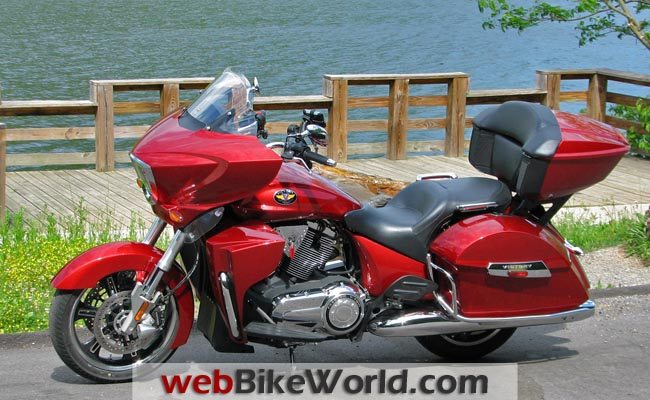
This is an area where the Cross Country Tour positively shines. The two saddlebags are huge – class-leading, according to Victory and I’ve seen my share of saddlebags, and don’t dispute that. The top case easily holds two full-face helmets.
Total storage, including the pods in the lowers, is said to be 41.1 gallons (c. 156 liters for the rest of the world; put another way, about 22% more than an Electra Glide).
Per Victory: “The Cross Country Tour has the most storage space of any motorcycle in the world.”
The saddlebag lids swing outward on a hinge, with the locks next to and below the passenger’s portion of the seat.
The top case is hinged by the passenger backrest on it; yeah, Harley’s TourPak side hinge is probably a better idea – you can’t have everything.
The pods just snap close. If you want to spring for them, Victory sells pod locks.
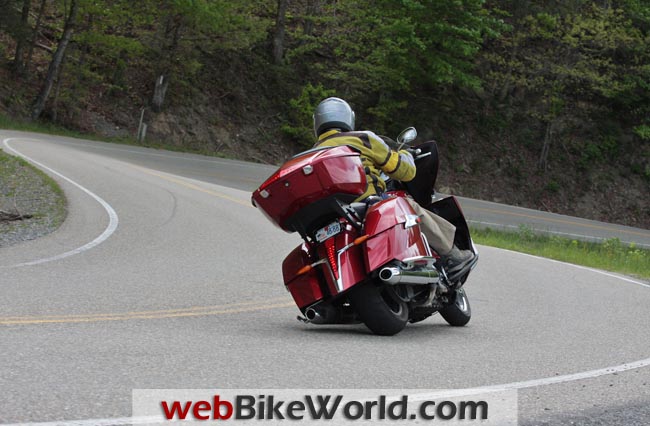
Other Amenities
The Victory Cross Country Tour cruise control is excellent.
If you’re holding the throttle steady and you press and release the cruise control “Set” button, and loosen your grip, there is absolutely no change in speed, no hiccup, nothing.
And it holds the speed nicely, even in sixth gear on steep grades.
The controls for the cruise are accessible via the right thumb, on a small plate by the throttle grip.
The heated grips have a low/off/high rocker switch on the dash, and do a fine job.
After a stop in a recent ride, I switched from cool-weather gloves to lighter gloves, and left the grips on low; after a few minutes – the temperature had gone up to 60-something by then – the heat was definitely too much, and I turned off the grips.
The heated seats have low/off/high toggle switches – one for the front and one for the back – located in a nook-and-cranny area just aft of the rider’s portion of the stepped seat, on the left side.
I tend to ride in cold weather with over-pants (FirstGear HT version), and add their liner if it’s really cold, so this doesn’t matter that much to me.
We were doing a day-long leaf-peeping ride recently, and at our first stop I reminded my wife, who was in jeans, about the switches; at the second stop, she remarked how well the system worked, and how welcome it was.
The XCT has a built-in radio, with four speakers: two in the fairing and two in the top case (on the outside of the passenger backrest area). There’s also an iPod (or, I suppose, iPhone) connector in the left pod.
There are functions for AM, FM, Aux, the iPod, and a CB, if you add one. The switchgear for all of this is inboard of the left grip, on a little mounting plate.
But, forgive me (or not), I admit it: I can’t tell you beans about how good any of this is, or how well it works. Simply, I don’t do tunes while riding.
There are three cigarette-lighter style outlets on the Cross Country Tour: one in the fairing, one in the top case and a third resides inside the left pod (corrected from two in the original posting).
Both are covered by rubber flaps, and both are “hot” with the engine on or off.
Victory sells Powerlet outlets, or you can add them yourself; there are two areas that seem intended for them, both on the left side: one under the tank, near the seat, and one way down low, in the front, by the battery.
The high beam on the Victory Cross Country Tour is a halogen bulb, and the low beam was an HID light. For 2013, Victory deleted the HID in favor of a halogen low beam, too.
All of the other lights are LEDs, and they are all very bright: the amber front and rear turn signals (with a four-way flasher switch by the left grip); the white license-plate light; and the red rear running/brake lights.
Regarding those last two, one is about 13″ tall, and “Frenched” into the rear fender, and the other is integrated into the top case lid, and is about 13″ wide. Nice job, all around.
I’d prefer, if I were to nit pick, that the turn signals were also running lights, and that the top case light was split in two, so that it could also function as a duplicate, high-eye-level, turn signal.
Disclaimer #3: Those lights you see down by the front brake calipers are not stock, and are not sold by Victory; they are Motolights (whose halogen bulbs I’ve replaced with 5-watt LEDs, if you must know).
Last, the dash gauges – speedo, tach, gas, and volts – are very readable in daylight. At night, they retain this readability with nice blue backlighting.
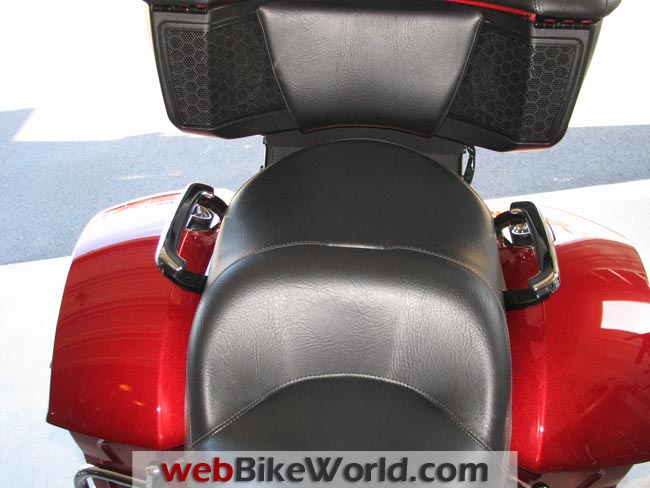
Maintenance
The Victory Cross Country Tour has an air-cooled engine, so there’s no coolant to change. It has hydraulic valve adjusters, so there are no valves to adjust.
And you don’t have to worry about final-drive gear oil, nor is there a chain to adjust or lubricate.
It has one engine oil drain plug, and one place to put in a fresh supply of oil. There is no bodywork to remove to get at the oil filter.
OK, so the final-drive belt is supposed to be replaced every 30,000 miles. And the air filter is under the fuel tank.
And, of course, you’ll have to change the two spark plugs once in a while, flush and refill the brake system, and replace the fuel filter. But that’s it.
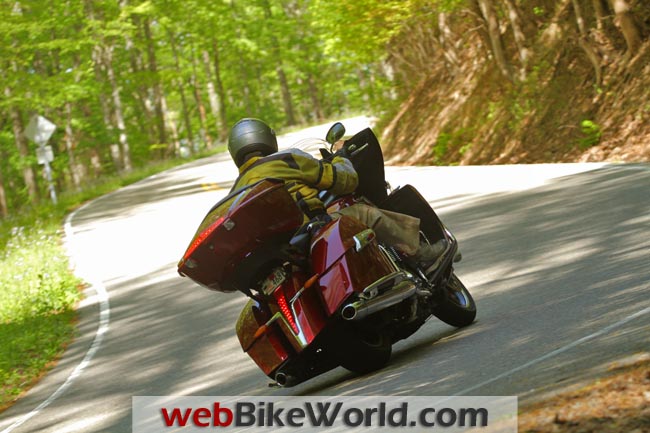
What Victory Needs to Improve
What you might have picked up on by now is that Victory sometimes backslides, and sometimes needs to be reminded to keep it classy.
There are some nice touches on the Cross Country Tour; the fenders are steel, and you certainly don’t need to add a fender extender or mud flap to the front (or rear, for that matter).
The gas tank is smooth and without a flange along the bottom. The seat flows into the tank.
The saddlebag crash bars are standard, as are the ones up front (which the pods/lowers attach to).
But…What’s up with dropping the HID low beam? You have a unique feature, and you ditch it?
I noticed in one of the magazines that the H-D CVO Road Glide gets LED headlights this year. Maybe Victory is getting ready to join suit?
And what’s up with a cable-operated clutch? My 2000 Valkyrie had a hydraulic clutch, for cryin’ out loud, and it was hardly the top-of-the-line for Honda.
I carry a replacement cable, which can easily get lost in one of the cavernous saddlebags, but still…
In typical bike fashion, the Cross Country Tour horn is of the Road Runner “meep, meep” variety. I replaced mine with a relay-triggered Stebel Nautilus air horn (review) , inside the fairing.
The switches for the heated seats ought to be rocker switches, not toggle switches. While they’re tucked out of the way, it’s possible to bump them, and you certainly can’t tell at a glance what position they’re in.
And you can’t tell from the photos, but those fork guards are plastic. About $30 apiece, and many owners have broken them. (You can buy metal fork guards from KewlMetal – see Victory Resources – for $143).
There are a few other plastic parts that really should be metal, too, such as what’s known as the “cheese wedge,” which is that part that says “106” on it, between the cylinders on the right side.
The saddlebag lids are a source of forum complaints, and rightfully so. If I didn’t wear hearing aids off the bike and custom-molded ear plugs on it, along with a modular helmet, their rattling would bother me, too.
And while they have sufficient sealing and overhang to prevent any problem with rain, they let dust in quite easily.
There is no adjustment capability in either the hinge or latching mechanism.
The bottom line is that Victory needs to refine its tolerances in this area, or provide adjustment capability, or both.
Along those lines, the locking mechanism on the top case lid is a little weird. It’s a separate mechanism, i.e., not part of the snap closers. This is nice in that you don’t need to lock the top case (or the saddlebag lids) in order to close them.
However, the top case lid lock allows a good deal of travel, if some miscreant unsnaps the lid – very inviting for something used to pry it open.
The dash has a gear indicator, but the clutch must be engaged for it to work.
To find out if you’re in, say, first or second, you have to let out the clutch.
My buddy’s R 1200 RT has no problem indicating the gear with the clutch disengaged, and I’ve read that when the XC first came out, its gear indicator worked that way, too.
This maxim comes to mind: if you’re going to do something, do it right or don’t do it at all.
The gas gauge of the Cross Country Tour drops to the bottom about the same time the “Low Fuel” warning comes on, which is about when you have 50 or 60 miles left in the tank.
The warning is fine, but the fuel gauge pointer should be recalibrated such that it should then point to the top of the red-outlined warning area, not at its bottom.
Last, the engine puts out a lot of heat, and that’s especially noticeable when you’re not moving on a really hot day (say, 90 and up).
I don’t know whether Victory has any wiggle room left with this engine, in terms of EPA approval; if they do, they should use it to make the engine less lean… and as I understand the matter, therefore generally less hot.
That R 1200 RT I mentioned runs about 20 degrees cooler in the cylinder-fin area than the Cross Country Tour – I’ve checked periodically, with a non-contact thermometer.
Yes, the Beemer has a smaller engine, but it’s also very powerful, too. Now, for you folks who are used to air-cooled twins, this may not be an issue.
Forum posts indicate that H-Ds get even hotter, and Victory has not felt the need to shut down the rear cylinder, by using something akin to Harley’s “parade mode” on certain bikes.
I ride Harleys every year at Americade (in large measure because they’re the only vendor who lets you go out on your own – on a prescribed route – on everything but V-Rods).
Americade weather is usually not hot enough for a good test of heat output, but every once in a while it is.
I rode a Buell Ulysses a few years back on a very hot day, and at the first stop was wondering whether I should’ve been wearing a Nomex suit, especially on my right leg (although the ride itself was a joy).
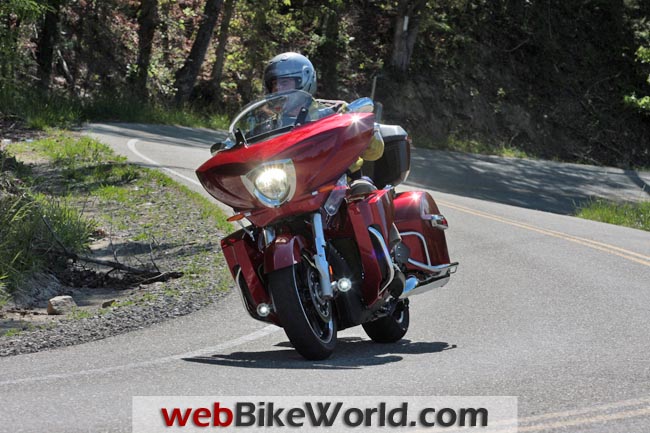
The Bottom Line
Let’s say my wife and I are going on a two- or three-week trip, which will include plenty of scenic by-ways, some Interstate traveling, and a dash of everything else found in on-road riding.
If I were to have my pick of any bike, I’d choose the Victory Cross Country Tour. You’re probably asking yourselves, “What the heck is he smoking?”
No, really, I’m serious. Let’s review: Fine handling, suspension, and ground clearance. Very good power, shifting, and ABS braking.
Very good weather protection, and air-management adjustability. Excellent ergonomics – seats (front and back), feet options (front and back), etc.
Excellent amenities – heated grips and seats, cruise control, etc. Superb storage capacity.
You want to relax and stretch out? Check. The Gold Wing, Harleys, et al ., don’t have those expansive floorboards.
My wife thinks the ‘Wing has the best passenger accommodations going, but admits that the back seat of the Cross Country Tour is actually pretty good, including the back support.
And then there’s the adjustable mini boards back there.
Comfort is covered, front and back. And I’ve ridden on Road Glides, Road Kings (even rented one), Electra Glides, etc., and I feel cramped on them. Yeah, I know, the aftermarket has plenty of seats.
And longer floorboards? And Harley’s web site doesn’t even bother to list the suspension travel. And I don’t like how they shake at idle, either…
You want to pack multiple pairs of jeans and a hair dryer? The Cross Country Tour has it covered. You want a bike with as little as possible that can go wrong? Tubeless tires, too?
Check that off, as well. Not too shabby, huh?
A nice touring addition would be an electrically adjustable windshield (see my buddy’s RT, or my former Burgman Exec, or a current Connie, or…), but even a Gold Wing doesn’t have that, and it doesn’t have a fork-mounted fairing like the Cross Country Tour.
So that’s not a unique flaw, and at least you can add a manually adjustable one.
Now, I probably have a different definition of a “tourer” than most of you, anyway.
I’d insist that a tourer have a feet-forward riding position, or at least straight down. If you think that’s a strange requirement, how do account for all the highway peg sales in the world?
And if you’re going to stretch out that way, you might as well have the controls up there, too. Yes, that almost excludes the ‘Wing.
Hey, I rode a feet-straight-down Valkyrie for seven years; while that’s comfortable, any one position gets old after an hour or two, in my opinion. I’d exclude the ‘Wing on the basis of trying to get at its oil filter, too.
And it does exclude every Beemer.
I’d leave out BMW, anyway; their K 1600 GTL (report) has a back seat that covers half of the passenger grab rails (design by committee? multiple committees?) and that top case backrest is simply inadequate (as are the top case backrests on a lot of other tourers).
The one caveat I would add is that if that three-week tour’s destination is, say, New Orleans in August, I would opt for something water-cooled…maybe the Vulcan 1700 Voyager.
I rode the Vaquero (essentially the same thing, sans topcase) at Americade last June, and it was a similar experience to riding the XCT or an XC… but just a bit less so, in whatever feature you’re talking about.
On the other hand, one of the “less” categories was definitely engine heat. Sure, the Cross Country Tour is not perfect; no bike is.
Having said that, it has what you need, and most of what you want, to go for a long ride, and do it in style and comfort and ease. Just fire it up, and roll. So I’m sticking with my choice.
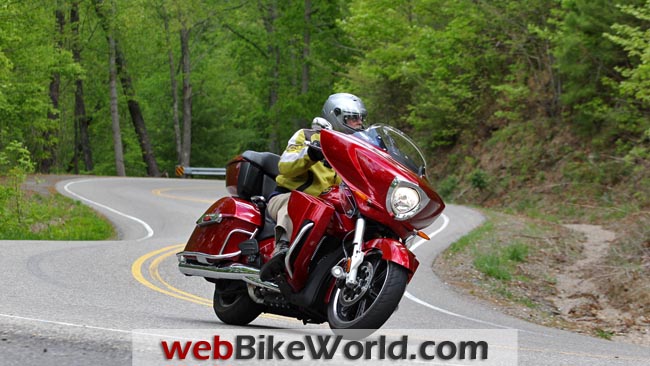
Victory Resources
Victory, the “other” American motorcycle company, seems to be doing well.
At any rate, it has done well enough that a cottage industry of Victory-exclusive or at least Victory-oriented aftermarket suppliers has sprung up. Here are the ones I’m aware of.
Victory-Oriented Aftermarket Companies Lloyd’z Motor Workz | KewlMetal | CycleOps USA | WitchDoctors | Heavy Metal Designz | Rick Fairless’ Strokers Dallas
Aftermarket Windshields for the Victory Cross Country Tour MadStad Engineering | Gustafsson Plastics | Clearview Shields | Cee Bailey’s Aircraft Plastics | 7Jurock Plastics
Victory Internet Forums VictoryForums | TheVOG.Net
Owner Comments and Feedback
From “C.N.” (March 2014): “I felt compelled to drop you a line and thank you for such a well thought out and comprehensive review of your Victory Cross Country. Hands down the best one I’ve read, and the most extensive (not to mention open and honest).
I nearly bought a XC myself last year, but financially I decided it was best to wait until this year.
The new changes to the HD’s have caught my eye though (“Project Rushmore”), and after riding my father’s 2013 Ultra Classic I put HDs back on the table.
Having said that, I’ve never ridden a Victory as the only local dealer doesn’t seem terribly interested in offering one.
Your review has definitely reminded me of why I was interested in the XC in the first place — they just seem to be better thought out. I’ve been a sportbike rider since my late teens (I survived!), so this is my first foray into the cruiser/touring world.
I still have my sportbike (a mint Suzuki GSXR1K5, best sportbike ever made if you ask me), but it simply is not up to the task of the longer rides my girlfriend and I are interested in. A proper trip on a sportbike can be pretty torturous.
Going back to the XC, one of the things that still gets my goat is the cheap looking trim (e.g. the “chrome” surrounding the headlight). It just looks flimsier than it should.
Compare that to a new HD’s proper fit and finish, and some of the Victory’s cockpit/fairing bits just looks like they should have a “MADE IN CHINA” label half-stuck to the bottom.
The cruise control buttons and whatnot I’m not terribly thrilled with either. If I had one other complaint about the XC, it’s the ignition position/key setup. The HD just seems much sturdier and well made.
Anyhow, if you’ve read my blurb up until this point, thanks again for your write up. I thoroughly enjoyed it.
Any feedback, suggestions, or warnings as I continue my research and pondering is welcome and appreciated. Thanks again and take care.”
Bill’s Reply: Having ridden the Tour for another year now after writing the review, I still think it’s a terrific bike.
I completely agree with you regarding H-D, though: they have better paint, more attention to detail, and seem to put more thought into overall integration.
Victory falls short in these aspects, and I agree that items such as the cruise-control and radio buttons look kind of just tacked on.
That said, I think the Victory is still a much better long-distance mount, with its better handling and clearance, better suspension, smoother (at idle, anyway) and more powerful (stock) engine, larger storage capacity, and roomier ergos.
I have an H-D dealer about two miles from me, which I often visit, and I continue to test-ride all the Harleys at Americade (less than an hour away) each summer.
And I have a Victory dealer 14 miles away, where I go every time the factory demo fleet is in town, so I keep up with developments.
Since the perfect bike still awaits both of us, it’s a matter of deciding on priorities while we’re waiting.
Also: See this thread on the Victory forum. The poster wanted responses from current Victory owners who had switched from H-D, asking why they switched, and got a couple dozen cogent answers.
Since I’ve only ridden and rented — but never actually owned — a Harley, they provide insight that I can’t.
From “S.O.” (August 2013): “Great article Bill. I too drive a ’12 XCT, red, just like yours. Love it. 15K in 1.5 seasons and it’s been great. Just today in the ship for the first “repair” for my ABS light coming on.
One thing I don’t have is the passenger grab rails. Vic wants $300. You mentioned yours were not Ma Vic’s. Where’d you get them and how much dinero??
Bill’s Reply: I see now that — if you can imagine this! — I wrote a statement that was unclear. I wrote: The passenger grab rails you see on my bike are not stock!
What I meant by that was that the grab rails are not part of what you get when you buy a Victory “Cross” bike.
That is, I didn’t want readers to think that if you buy an XCT, what you see (in the wBW pictures) is what you get (with regard to the grab handles or the windshield).
On the other hand, the grab rails are made by Victory — you just have to pay for them. Maybe I should have said, the way they do in car commercials, “optional equipment shown.”
As I stand by my description of the grab rails — they’re extremely robust and well-made — I think they’re worth the money.
In addition for use by an actual passenger, you can use them to grab onto if you ever need to “back-walk-up” a dropped bike and also for luggage tie-down points.
I have not read about any aftermarket supplier for grab rails for the Victory “Cross” bikes, so I think it’s Victory or nothing. Sorry about the confusion.
From “J.T.M.” (January 2013): “Nice bike, but: (1) It’s $22,600! These toys are getting a bit pricey. You can get a pretty nice 2013 Honda Accord Coupe for that much. Or, a real Harley-Davidson.
(2) I’ll never appreciate the looks of the Victory. The “Nessie” style just looks dated, to me. Not classic, dated.”
Bill’s Reply: “If you start with a similar H-D dresser — fork-mounted fairing, hard saddlebags, and a top case — you’re looking at the $19,699 Electra Glide Classic.
Add (single-color, non-black) paint, ABS (available only as part of the security package), cruise-control, and freight, to make the bikes more or less equivalent, you’re now up to $22,139.
You’ll have better security on the Classic, but you still won’t have the Victory’s suspension travel, cornering clearance, long floorboards, and storage volume.
And you’re more likely to get a greater discount at a Victory dealer, so we’re probably talking less money for the Tour.
I don’t know what makes a Harley any more “real” than a Victory, but they’re certainly in the same price range.
I agree that “these toys are getting a bit pricey.”
Not much you can do about that if you want a full-dressed touring rig. If you want to buy an Accord instead, that’s certainly an option, but it’s not nearly as much fun.”
From “J.K.” (November 2012): “I am on my second Victory Cross Country. I had an early 2010. I now have a 2012 Tour. I have a few quick comments.
I have not had my saddlebag lids rattle on either bike. There is a small amount of adjustment that is available on each lid (not sure if it will help or not).
I have ridden in very warm weather as well as quite cool weather. There seems to be some variance with peoples experience with heat.
I have ridden in the south during the summer and 100 degree days have not had any significant heat issues (100 degrees just standing is quite warm).
It seems that there may be some variation in some of the bikes that causes this issue for some people.
The HID lighting can easily be remedied for about $50 from Victory HID (it includes both the high and low beam — it makes daylight out of the night).
I had added to the 2010 and replaced the HID bulb in the 2012 with one of their bulbs as well.
Lastly, there are actually 3 power outlets. The two mentioned in the article, but also one next to the iPod connector in the left pod.”
I see you used to be a Valkyrie rider, I am still riding my 97 tour which I love but am considering the cross country tour to finally replace it. I would like your thoughts on comparing the two bikes. Power, ride, reliability, comfort on the long haul.
Comments are closed.
wBW is an A07 Online Property
- Advertising
- Privacy Notice
- Review Policies
- Terms and Conditions

We ride the 2024 Triumph Street 400 and Scrambler 400 X, and the 2024 KTM 990 Duke, in addition to travel and educational features. Buy the issue now.
- Gift Subscription
- Renewal and Client Profile Page
- How to Read Mailing Label

2011 Victory Cross Country

Plodding along Main Street in Winnipeg while fumbling with our limited amount of awkward baggage and helmets, we approached the intersection of Portage and Main, reportedly the windiest intersection in Canada. Whether that account is true or not, we felt the bite of the fierce chilly wind as it whistled up the street between the buildings, which function as a wind tunnel. It seemed the Weather Channel was wrong about the temperature, but I hoped that its prediction of no rain in the area for the next few days would be accurate. Although I was wearing my riding coat, I felt underdressed, and I hoped that the amenities of the 2011 Victory Cross Country would do a good job of blocking the colder-than-normal, early fall chill as we test-rode the bike for the weekend in rural Manitoba.
Victory Canada’s headquarters are located on the eastern edge of Winnipeg, just inside the ring road, and not the easiest to get to from downtown. The fact that our cab driver couldn’t really understand us and we couldn’t understand him was inconsequential, since we had given him a laser-printed address of our destination. Rather than getting lost, he got in touch with his office, and they tracked our location by GPS and fed driving instructions to him via his cell phone’s ear plug.
Never having ridden a Cross Country before, Gwen and I packed our bags according to the bike’s specs and photos and hoped that what we had brought would fit in the saddlebags. As a point of reference, Harley-Davidson saddlebag liners fit nicely; in fact, the saddlebags on the Cross Country are a little larger, about 22 cm wide, which allowed us to pack a few more things down the sides, the front and on top of the bag liners. The bag lids are easy to open with one hand and also remove easily for cleaning and to facilitate maintenance. Victory claims 79.5 litres of storage in the side bags. I wanted to fill them full of water to prove that number, but it would have taken too long to fill up a 500 ml water bottle 159 times, and we were under time constraints. In other words, I’d rather be riding than proving.
The folks at Victory were nice enough to attach a quick-disconnect backrest for Gwen at the last minute before we rode off into the chilly sunset. For those in need of even more storage on the Cross Country, there is an optional trunk that quickly mounts and dismounts without tools, according to the Victory brochure. This item was not in stock at the time, but the photos of it are not near as futuristic as the Vision’s trunk. While the Vision is not everyone’s cup of tea due to its futuristic looks, the Cross Country is a good-looking motorcycle in the traditional sense and should appeal to a wide range of riders in the touring crowd. It has pleasant lines and flows nicely from front to back, although the engine guard and rear fender are much bigger than they have to be.
My first impression of the bike as I initially sat on it was that the flat seat with a bum stop would be quite comfortable and the angular fairing should easily direct wind away from me. The windshield had been changed from the smaller stock windscreen to a massive piece of clear plastic that towered about 5 to 7 cm above my sightline. The windshield gained the affectionate nickname of the barn door. I much prefer the look of the shorter windshield and still like the wind on my face while riding, but I was thankful, because of the temperature, that the powers that be at the Victory office had chosen to change it to the optional larger version. Gwen, riding on the back, was also free of the windblast, which was deflected over her from the huge windscreen.
As I suspected, the riding position was very comfortable – back straight with hands and feet finding their home without stretching. With a seat height of only 667 mm (26.25 in.), it’s easy for a person of just about any inseam to touch the ground flat-footed. The flat, deeply sculpted seat doesn’t rotate your pelvis as many seats do, and therefore alleviates any stress on the lower back. Finding a relaxed spot for your feet is not a problem, as the floorboards are big – 457 mm (18 in.) long – I mean, move your feet just about anywhere and they are still supported. As long as the floorboards are, they taper at the end, so they are never in your way when you put your feet down.
Riding on the back for this trip, Gwen found it extremely comfortable, especially with the backrest mounted, and she never once complained of a sore butt. The passenger floorboards were at a comfortable height and allowed her some foot movement as well.
Instruments are easy to read and include an analog speedo flanked on the left by a fuel gauge. The speedo has the ability to change from mph to km/h for those travelling south of the border. An analog tach resides on the right side of the instrument cluster, with a battery voltage meter on its right. In between the speedo and the tach are a panel of idiot lights on the top with an LCD on the bottom. Your hands never have to leave the handgrips as the LCD, controlled by the left forefinger in front of the left switchgear, provides a wealth of information, including ambient temperature, gear selected, mileage, two trip meters, average and instant fuel consumption, average speed, range till empty and more. The stereo is plain Jane, at least in appearance, and resides under the gauges but all stereo controls are operated at the left-hand switchgear. What the stereo lacks in appearance it makes up in functionality. It is an AM/FM/Weather band/MP3/iPod/ Garmin GPS–compatible unit that will recognize the add-on components as they are connected.
Electronic cruise control is handled by the right hand with buttons on the right-hand switchgear.
Other than the safety of never having to take your hands off the handgrips, there’s another reason all controls are at your fingertips. The handlebars are long as they come back to meet you, making the fairing a long way away. It would be quite a stretch to reach any buttons if they were on the fairing. Reminiscent in scale of the Vision, the Cross Country is a little different in that the handlebar is round, not oval, allowing the easy mounting of a plethora of bracketry for electronic gadgets.
The fairing is well designed and kept the wind away from my hands and shoulders, while the fork’s wind deflectors did a fine job of keeping much of the wind from my legs.
The fairing is steering mounted, and while it’s common knowledge that crosswinds can affect the steering on a fork-mounted fairing, I blame the larger-than-life windshield, which acted like a sail during some of the gusts we experienced.
Leaving the Winnipeg area on the city’s ring road was a good test of the big V-Twin engine. Victory has ditched the 100 cu. in. engine in favour of the larger Freedom 106 cu. in. (1731 cc) in all of its models for 2011 – and what a sweet engine it is. The air- and oil-cooled, 50 degree, fuel-injected powerplant features self-adjusting cam chains, overhead camshafts, four valves per cylinder and hydraulic valve lifters. The resulting maintenance-free top end is smooth and quiet, and helps the engine build an impressive claimed rear-wheel 92 horsepower and a peak torque of 109 ft-lb (147.7 N-m) at just 3000 rpm. The engine continued to pull hard right into the upper reaches of the rpm range, which redlines at 5200.
We were riding pretty hard at the beginning, firstly because I had to see what the engine would do, and secondly because it’s fun, but once the novelty of the big Twin wore off, we slowed things down a bit as we got out on the open highway. Over the course of 1500 km, our worst fuel mileage riding two-up with luggage was 6.7 L/100 km (42.3 mpg) and our best result was a pretty respectable 5 L/100 km (56 mpg). Averaging that out, you should expect to get about 375 km out of the 22 litre tank.
At a highway speed of 80 km/h in overdrive sixth gear, the engine lopes along at only 2000 rpm. While the engine produces much of its power that low in the rev range, clicking down a couple of gears to fourth brings the revs up to around 2600, putting the engine in the vicinity of its maximum power range and making it much more suitable for quick, efficient passing of anything in your way.
The Victory six-speed transmission – installed in all 2011 models – has received so many upgrades and modifications, it might as well be called brand new. The non-adjustable clutch lever is a little on the stiff side, while shifting is easy, albeit with a heavier engagement clunk in lower gears – a trait of a powerful V-Twin. The previous version was a little whiny in the higher gears, and I found that selecting neutral was troublesome in the Vision that I rode last year. At the time of picking up the 2011 Cross Country, I didn’t know about the revised transmission, but I immediately noticed how easy it was to find neutral. Victory calls this modification “Neutral Assist.”
While rolling to a stop, or during a stop when the bike is in first gear, simply flicking your toe up on the shifter will result in selecting neutral, no ands, ifs or buts. The function of Neutral Assist will not allow the transmission to go into second gear, thereby eliminating the exercise in frustration of watching the neutral-light flash as the heavy gears bounce between first and second, and vice versa. Very slick. Power delivery to the 180/60-16 Dunlop out back is via a clean and quiet, carbon fibre–reinforced belt.
Riding two-up with a backpack and saddlebags loaded, the rear suspension felt a little spongy. It’s adjusted through an air valve that is accessible by popping off the right-side plastic cover, below the seat. I didn’t have a hand pump and didn’t want to risk adding too much pressure from a compressor and air hose, so we just lived with the soft ride. As a word of warning, and I can tell you from experience, it may be in your best interests not to mention to your better half that you think the rear suspension needs more air when she’s riding pillion. Even though the ride was a little soft, the cast-aluminum swingarm, with its 120 mm (4.7 in.) of travel – and a unique constant-rate linkage to the rear shock – did not hit bottom. Thank goodness, this saved me from the “I think the rear suspension needs more air with you on it” comment.
VICTORY CROSS COUNTRY (2010 - on) Review

At a glance
Overall rating.
Victory is no stranger to the custom-tour theme. The Cross Country is based on the Vision, an outrageously-styled grand tourer that spins heads everywhere. The Cross Country is in the same vein – modern sharp and curved lines mixed with traditional touches of half fairing and screen, tall bars, luxurious seating, stereo, solid panniers and so on. Traditional also meets modern with Japanese –spec switch gear, aircraft-filler fuel cap and suspension. As for the engine, gorgeous, thudding greatness you’d expect from an air-cooled V-twin. A definite alternative American machine to the great American alternative from Milwaukee.
Ride quality & brakes
Weight and high-ish bars conspire against shorter riders. It makes slow 360° turns in car parks frustrating when arms struggle to achieve full-lock. But when you’re away the bike is surprisingly agile and oh so stable. Rear suspension is set to firm but not uncomfortably so. It allows you to feel what’s going on underneath you. The front end is softer so doesn’t give the same level of feel as the rear, but it copes well with the engine weight and under braking. Ride quality is plush and comfortable, but six-footers will need the taller screen that is available.
Air-cooled engine rumbles are a plenty at standstill to give this engine character and the rider a smile. The smooth delivery of torque makes pulling away on a 345kg (dry weight) bike a lot easier than you’d think. Throttle response is weighted perfectly so you can dial in exactly what your brain demands – slow traffic isn’t such a bad place when you can simply trickle along without worry. But it’s the open road where the engine excels; where every gear is precisely engaged and neatly spaced for the twists and turns or flowing A-roads.
Reliability & build quality
Polaris Industries, the company behind Victory, make big noises about quality – mostly about how its American-made bikes should be world leaders in this area. So far the majority of its customers (and MCN) have nothing bad to say about the brand; the price of the accessory topbox being the exception…
Value vs rivals
A bike of this calibre – big, stylish air-cooled touring V-twin – at a price just above Japanese competition, and slightly more affordable than a Harley should not be dismissed. Victory is making big waves in the custom and custom cruiser market through value and quality, and this is translated in sales and happy owners. Find a Victory Cross Country for sale .
Love the solid, locking panniers and (as shown) the cavernous topbox, except the topbox – complete with high mounted lights, rear speakers and 12V socket – is a £1869 accessory. Gulp! And this is the reason why it’s not four-star rated in this section. Nicely made, though. The stereo is also cool and comes with the usual bar-mounted volume/tune access switches. Cruise control is perfect on average speed camera roads. And while the spoiler-like crash bars grate on first sight, like the rest of the bike’s styling you soon fall for the uniqueness. Compare and buy parts for the Victory in the MCN Shop .
Model history & versions
Model history.
2010: UK introduction of Victory Cross Country
Other versions
Victory Cross Roads – an un-faired version of the Cross Country Victory Vision Tour – a fully dressed modern super-tourer running the same 1731cc engine.
Owners' reviews for the VICTORY CROSS (2010 - on)
3 owners have reviewed their VICTORY CROSS (2010 - on) and rated it in a number of areas. Read what they have to say and what they like and dislike about the bike below.
Review your VICTORY CROSS (2010 - on)
Version: 1731 crossroads bagger
Annual servicing cost: £450
Paint work and chrome Poor ,Dealers far and wide,Parts hard to source in the Uk and extremely expensive ! Brilliant looking bike handles well, but would not recommend to a friend
Brakes excellent,( Abs ? } average one and half hours before needing break
Can't fault engine performance !
A generally good but chrome work very poor , Abs stopped working, tried everything from new sensors at £150 a go, to replacing brake fluid Dealers said nothing wrong when put on computer ??gave up and sold bike !
mpg high averaging 35 cruising
It's looks . Would avoid any accessories as extremely expensive!
Buying experience: Poor ,soon as sold bike no interest from dealer even put wrong reg on number plate. Recall for rear brake rout done had to involve Polaris also had recall on sissy bar and rack!
Version: 2014 1731 cc Crossroads
Extremely fun to ride, handle like a dream, One down fall the paint work is poor ,parts hard to get hold of and extremely expensive , Turning difficult unless on a very wide road! otherwise wold definitely recommend to a friend !
Excellent ride quality,can ride for 2 hours before needing a break. brilliant handling and controls well at walking pace in slow traffic .
Great performance
6 year old and already needing both fenders needing full paint job! Abs sensors need replacing
Running costs reasonable
Overall as a bagger the bags flow well with the look of the bike , only downside you can not ride the bike with the bags removed . Avoid rack as very poor quality chrome !
Buying experience: Purchased from dealer New , paid £11500. Poor dealership service
@2014 it is no doubt a much better bike in all ways compared to the other U.S. brand.
seat is so comfortable that both pillion has no complain after 15 days Singapore - Golden Triangle.
loads of torque.
the material used on this bike is superior as compared to other baggers in the market.
for 4 years & 25,000 km on the clock, I need nothing more then normal oil & filter change. Highway riding, 80~110 km/h I can get over 400 km before the reserve lights up, giving me ^ 22.5 km/ l.

- Search bike reviews
- Search all bikes
- Search new bikes
- Sell your bike
- Latest news
- Motorcycle Live
- Accessories
- Base Layers
- Communication
- Riding tips
- Learn to ride a motorbike with MCN
- Electric motorbikes
- Maintenance
- Travelling touring
- Insurance guides
- Buying and selling
- Inspiration
- Members' Content
- The Newspaper
- Latest Issue
- #Ride5000miles
- Buy Official MCN Merchandise
- MCN Festival
- London Motorcycle Show
- Racing News
- Shows & Events
- Promotions / Specials
- Motorcycle Specs
- Snowmobile Specs
- Motor Boat Specs
- Personal Watercraft Specs
- Utility Vehicle Specs
- Motorcycle Comparison
- ATV Comparison
- Snowmobile Comparison
- Motor Boat Comparison
- Personal Watercraft Comparison
- Utility Vehicle Comparison
- Motorcycles
- ATVs & Utility Vehicles
- Snowmobiles
- Personal Watercrafts & Motor Boats
- Pre-Owned Motorcycles
- Pre-Owned ATVs
- Pre-Owned Utility Vehicles
- Snowmobiles Comparison
- Pre-Owned Snowmobiles
- Pre-Owned Motor Boats
- Pre-Owned Personal Watercrafts
- Our Writers
- Dealers Search
- Auto123.com
- Auto-Venus.com
New Members
Centre Honda Chambly
Le Spécialiste du VTT
Desjardins St-Adele Marine
Performance GP Montmagny Inc
Cloutier Sports
Motosports St-Apollinaire
In order to serve you better, select your area code in the drop down list below.
Aller à la version française
© 2000-2024 DealerCorporation.com. All Rights Reserved - About moto123 - Careers - Partners - Advertising
Please read our Confidentiality Policy and our Terms Of Use .

Victory Cross Country - 2011 Specifications and Reviews
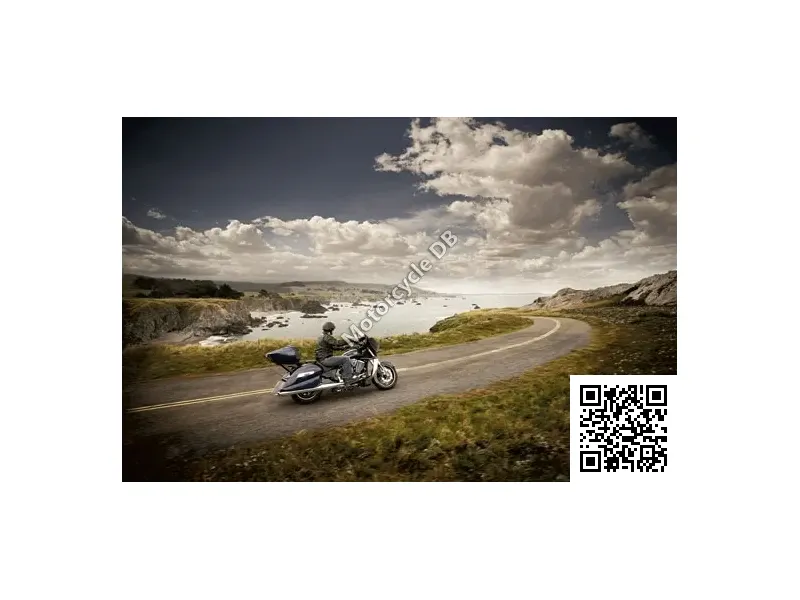
Rider Reviews
Add a comment, related motorcycle specifications.
2024 Herald Maverick 125

2024 Ducati Panigale V2 Bayliss

2024 BMW R 1250 GS Adventure

2024 Zero SR-F

2024 Honda X-Adv

2024 Husqvarna 701 Enduro

2024 Benelli BKX 250 S

2024 Vespa GTS 300

2024 BMW K 1600 B Midnight

2024 Indian Chieftain Elite

2014 Honda Wave 100R


2013 Suzuki Raider J Pro 110

2008 Hero Honda Splendor Plus

2013 Suzuki Shogun Pro 125

2010 Hero Honda CD Deluxe

2018 Yamaha Mio Sporty

2011 Modenas Dinamik

2010 Hero Honda Passion Pro

2007 Hero Honda Glamour

2009 Hero Honda Splendor Plus

Database Staus
- Motorcycles in database: 34383
- Technical specifications: 1152152
- Images of motorcycles: 57274
- Videos: 339
- Manufacturers: 475
Victory Cross Country (2010-11) technical specifications
Victory Cross Country is produced in 2010-11. Engine is Four stroke, 50° V twin SOHC, 4 valves per cylinder, self-adjusting cam chains, hydraulic lifters, displacement 1731cc /106 cu-in , produces power 96.9 hp / 71.3 kW and 153 Nm / 15.6 kg-m. Victory Cross Country weighs 347 kg / 765 lbs. Victory Cross Country has 3 photos.
Technical specifications
Riders reviews.
Reviews score
Compare bike.

Moto-data World

Riders submitted photos
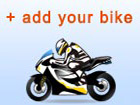

- by Brand
- by Year
- by Category
- New 2024 models
- All 2023 models
- Newest additions
- 50cc motorcycles
- 125cc motorcycles
- 150cc motorcycles
- Electric motorcycles
- 1960s motorcycles
- 1950s motorcycles
- 1940s motorcycles
- 1930s motorcycles
- Contribute your specs / pics
- MC of the Year
- Advanced search
- Unit converters
- Words & terms
- Riding safety
- Insurance quotes
- News & reviews
- General topics
- Motorcycle brands
- Motorcycle categories
- Best forum for your bike
- Latest discussion posts
- Free classifieds
- Account Settings
Classifieds
Bike reviews, product reviews.
- Best Motorcycle Cameras
- Best Motorcycle Earplugs
- Best Motorcycle Oil
- Best Leather Jackets
- Best Winter Gloves
- Best Sportbike Tires
- GPS Buyers Guide
- Adventure Touring
- On-Off-Road
- Sport-Touring
- Touring Scooter
- Harley-Davidson
- Royal Enfield
New Rider's Hub
Top stories.

2011 Victory Cross Roads® Core Custom

Identification
Transmission, wheels & tires, technical specifications, instrumentation, paint & finish, convenience, user reviews, i test rode the victory cross roads, rating breakdown.

Find your Motorcycle
Specs classifieds, similar motorcycles, you may also be interested in.

2011 Victory Cross Country™ Corey Ness $24,999 MSRP

2011 Victory Vision™ Tour $23,199 MSRP

2011 Victory Vision™ 8-Ball $17,999 MSRP

2011 Victory Vision™ Arlen Ness $27,999 MSRP

2011 Victory Cross Country™ $17,999 MSRP

2011 Victory Vegas® $14,999 MSRP

2011 Victory Vegas® Jackpot $18,499 MSRP

2011 Victory Hammer® 8-Ball $14,499 MSRP

2011 Victory Hammer® $17,799 MSRP

2011 Victory Hammer® S $18,499 MSRP

2011 Victory Kingpin® 8-Ball $12,999 MSRP

2011 Victory Kingpin® $14,999 MSRP

2011 Victory Vegas® Zach Ness $18,999 MSRP

2011 Victory Vegas® 8-Ball $12,499 MSRP

2016 Victory Magnum® X-1 Stealth Edition $23,499 MSRP

2017 Victory Vision® $21,099 MSRP

2017 Victory Cross Country® Tour $21,999 MSRP

2017 Victory Cross Country® $19,499 MSRP

IMAGES
VIDEO
COMMENTS
Victory Cross Country Tour Features and Benefits. 106 CUBIC-INCH FREEDOM V-TWIN. At the heart of the Cross Country Tour sits the Freedom V-Twin power plant, expertly balanced for the perfectly controlled explosions that deliver 97 horsepower and 113 ft lbs of hole shot torque.
3.9 See the detailed rating of touring capabilities, reliability, accident risk, etc. Compare with any other motorbike. Engine and transmission. Engine size. 1737.1 ccm (106.00 cubic inches) Type of engine. V2, four-stroke. Engine details.
Specs; 2011; Victory; Touring; ... I swapped my Street Glide for my buddy's Victory Cross Country a couple weekends ago, and I have to admit, I became addicted to the power and the handling this bike provided. Victory is becoming more and more popular in my area and now I know why. ... 2011 Victory Vision™ Tour. $23,199 MSRP. 2011 Victory ...
The 2012 MY Victory Cross Country Tour boasts one of the biggest storage capacity among all the motorcycles designed by the House of Spirit Lake, with a more than generous 41.1 gallons inside its ...
In 2012, the Victory Cross Country Tour list price was $21,999 in black, $22,499 in red or white. And my simplistic color names don't do the paint job justice, as we're talking a sort of metal-flake, even in black…. For 2013, the choices are now black ($21,999, as before), or blue and a kind of bronze (all upped $100 to $22,599).
That, coupled with its 5.8-gallon tank, gave it a potential range of 290 miles. This year, in more conventional all-round city/country usage, our test bike averaged 38.6 mpg. The bike is suspended ...
The resulting maintenance-free top end is smooth and quiet, and helps the engine build an impressive claimed rear-wheel 92 horsepower and a peak torque of 109 ft-lb (147.7 N-m) at just 3000 rpm. The engine continued to pull hard right into the upper reaches of the rpm range, which redlines at 5200.
2011 Victory Cross Country™ Corey Ness pictures, prices, information, and specifications. Specs Photos & Videos Compare. ... 2017 Victory Cross Country® Tour. ... Specs; 2011; Victory; Touring; 2011 Victory Cross Country™ Corey Ness.
Buying experience: Purchased from dealer New , paid £11500. Poor dealership service. 4 out of 5 Victory Cross review. 13 September 2019 by Comics00. Year: 2014. @2014 it is no doubt a much better ...
Ideal powerplant. The heart of the Cross Country consists of a 1,731cc (106 ci) V-twin that produces 87 hp at 4,900 rpm. Surprisingly flexible at low revs, the engine allows you to cruise at under 2,000 rpm and, from there, it accelerates beautifully and without turning a hair. However, I found that it usually works best from 3,000 to 4,000 rpm.
Everything you need to know about the 2011 Victory Cross Country Including Pictures, specifications, videos and reviews - Driveline: Gear drive with torque compensator. Carbon Fiber Reinforced Belt. ... Victory Cross Country - 2011 Specifications and Reviews. 2017. 2016. 2015. 2014. 2013.
Seat Height: 26.25 in OR 667 mm. Weelbase: 65.7 in OR 1669 mm. Ground Clearance: 5.8 in OR 147 mm. Weight: 765 lbs OR 347 kg. Fuel Capacity:
Victory Cross Country (2010-11) technical specifications Victory Cross Country is produced in 2010-11. Engine is Four stroke, 50° V twin SOHC, 4 valves per cylinder, self-adjusting cam chains, hydraulic lifters, displacement 1731cc /106 cu-in , produces power 96.9 hp / 71.3 kW and 153 Nm / 15.6 kg-m.
by Pete Brissette. Published: April 1st, 2012 Share. Victory's Cross Country has left a positive impression on the motorcycle-buying public as well as the moto media in the past two years, earning Best Cruiser in our Best Of 2010 awards. For 2012 Victory has expanded the Cross Country into the Cross Country Tour.
Split dual exhaust with crossover. Chassis, suspension, brakes and wheels. Rake (fork angle) 29.0°. Front suspension. Inverted cartridge telescopic fork, 43 mm diameter, 5.1 in / 130 mm travel. Rear suspension. Single, mono-tube gas, cast aluminum with constant rate linkage, 4.7 in / 120 mm travel, air adjustable.
Typical Listing Price. $6,050. In Good Condition with typical mileage. When trading in at a dealership. Standard engine specs: 2-Cylinders, 4-Stroke, 1731cc.
2011 Victory Cross Country Base Specifications, Model Information, and Photos Motorcycles For Sale ... Vehicle Specifications 2011 Victory Cross Country Base. Front Brake Type. Dual Hydraulic Disc. Rear Brake Type. ... 2014 Victory Cross Country Tour . $9,000 . 2016 Victory Cross Country ...
The Cross Country's air/oil-cooled, 50-degree V-twin engine displaces 106 cubic inches (1,731cc) and is a staple across the Victory line. Unlike the other two bikes in our test, its V-twin has ...
2012 Victory Cross Country™ Tour pictures, prices, information, and specifications. Specs Photos & Videos Compare. MSRP. $21,999. Type. Touring . Insurance. Rating #1 of 8 Victory Touring Motorcycles. ... I test rode the Cross Country several times in 2011, once they came out with the Touring model, I knew what I needed to do. ...
I own a 2012 Vic Cross Country, rides far nicer than the Harley Street Glide I owned. Smooth transmission shifting, I changed the stock windshield, no buffetting now. Lots of bottom end torque, 5th gear handles excellent around 110km/h
The Victory Cross Country Tour seat height is 667 mm (26.3 inches) If adjustable, lowest setting. How many gears does a Victory Cross Country Tour has? The Victory Cross Country Tour has 6 gears. Victory Cross Country Tour Touring Victory 2015 384.0 kg (846.6 pounds) V2, four-stroke 143.74 Nm (14.7 kgf-m or 106.0 ft.lbs) Victory Cross Country ...
2011 Victory Cross Roads® Core Custom pictures, prices, information, and specifications. Specs Photos & Videos Compare. MSRP. ... 2017 Victory Cross Country® Tour. ... Specs; 2011; Victory; Touring; 2011 Victory Cross Roads® Core Custom.